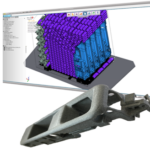The 1950s hailed petroleum-based materials as revolutionary for surfers, providing lightweight, durable, and flexible surfboards. However, these materials now pose environmental threats. Jérémy Lucas, a surfer-entrepreneur from Brittany, France, is addressing this contradiction. His venture, Paradoxal Surfboards, has utilized beached seaweed, abundant in Brittany, to 3D print surfboards.
This initiative converts the environmentally problematic beached seaweed into valuable raw material for 3D printing, reducing waste and promoting eco-responsibility.

The process involves collecting, drying, and crushing the algae to produce a thermoformable material for 3D printing. The surfboard’s design takes inspiration from the biological structure of green algae, with the prototype being printed in two parts that are subsequently heat-sealed. After printing, the board undergoes laminating/glassing to seal it.
The initial model has shown promising results in terms of performance and durability, with future models considering the use of flax or hemp fiber.
Of course, surfboards are fairly sizable things and cannot be printed on your average desktop 3D printer, which is why the company turned to Modix, who provided the large format FFF printer, to fabricate the boards in a single part. You can see the Modix machine printing the board in the image below.

In terms of raw materials, approximately 2 kg of seaweed is processed down to 1 kg to create a single board. These surfboards not only reduce environmental impact but also offer exceptional performance attributes like chop cushioning and remarkable maneuverability.

The brand is set to commence pre-sales next year and is exploring expansion into other water sports, and it is looking promising for the company as they have recently received first place in the Ocean Pitch Challenge 2023.
Looking ahead, the introduction of such sustainable surfboards indicates a potential shift towards more eco-conscious practices in the surfing domain.
Source: surfsimply.com
Come and let us know your thoughts on our Facebook, Twitter, and LinkedIn pages, and don’t forget to sign up for our weekly additive manufacturing newsletter to get all the latest stories delivered right to your inbox.









